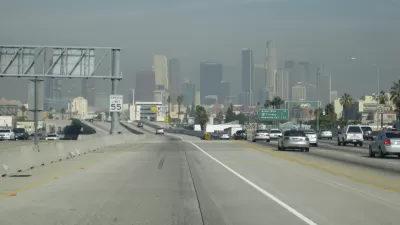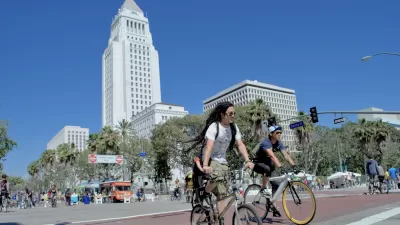The improvement in air quality comes from reductions in toxic emissions from autos, trucks, and ships. Enjoying the cleaner air were tens of thousands of Angelenos riding on miles of streets closed to auto traffic for the 10th CicLAvia event.
Risk of getting cancer from "exposure to 37 toxic pollutants—including diesel soot and arsenic," has been reduced by 65% according to a "study released by the South Coast Air Quality Management District on Oct. 2," reports Kristina Bravo of TakePart. By contrast, "(t)he last review reported a 17 percent drop between 1999 and 2005," she notes.
The greatest cancer risk from airborne emissions, 68.2 percent, comes from diesel particulate matter, as shown by Figure ES-3 in the report [PDF] and as explained by environmental reporter Tony Barboza of the Los Angeles Times.
Diesel exhaust remains the largest contributor to the problem, the air district's analysis found, and is responsible for more than two-thirds of all air pollution cancer risk in the region. About 90% of the risk comes from mobile sources, including cars, trucks, cargo ships, locomotives and airplanes.
Notwithstanding the pollutant reductions, Bravo reminds us that "compared with the rest of the nation, Southern California is still among the worst places to breathe."
However, Angelenos did breathe easier on Sunday, October 02, particularly those enjoying streets with no auto traffic thanks to the tenth CicLAvia event, which Bravo covers in a separate piece. She speaks with Jonathan Parfrey, "vice chair of the CicLAvia Board of Directors and the executive director of Climate Resolve, an organization that pushes for climate change action in the city."
FULL STORY: The Air in Southern California Just Got a Whole Lot Cleaner

Study: Maui’s Plan to Convert Vacation Rentals to Long-Term Housing Could Cause Nearly $1 Billion Economic Loss
The plan would reduce visitor accommodation by 25,% resulting in 1,900 jobs lost.

Alabama: Trump Terminates Settlements for Black Communities Harmed By Raw Sewage
Trump deemed the landmark civil rights agreement “illegal DEI and environmental justice policy.”

North Texas Transit Leaders Tout Benefits of TOD for Growing Region
At a summit focused on transit-oriented development, policymakers discussed how North Texas’ expanded light rail system can serve as a tool for economic growth.

San Diego County Sees a Rise in Urban Coyotes
San Diego County experiences a rise in urban coyotes, as sightings become prevalent throughout its urban neighbourhoods and surrounding areas.

Los Angeles County Invests in Wildfire Recovery for Parks, Trails, and Open Space
The $4.25 million RESTORE Program supports the recovery of parks, trails, and open spaces damaged by the January 2025 wildfires through targeted grants that promote community healing, wildfire resilience, and equitable access to nature.

Nevada Bills Aim to Establish Home Insurance Assurance Amidst Wildfire Risk
Republican sponsor hopes the FAIR plan would be “a true market of last resort.”
Urban Design for Planners 1: Software Tools
This six-course series explores essential urban design concepts using open source software and equips planners with the tools they need to participate fully in the urban design process.
Planning for Universal Design
Learn the tools for implementing Universal Design in planning regulations.
Alamo Area Metropolitan Planning Organization
City of Santa Clarita
Institute for Housing and Urban Development Studies (IHS)
City of Grandview
Harvard GSD Executive Education
Toledo-Lucas County Plan Commissions
Salt Lake City
NYU Wagner Graduate School of Public Service




























